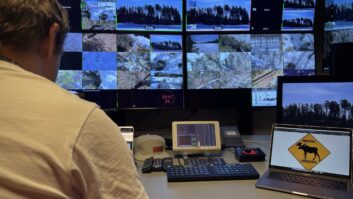In the days before the pandemic changed the face of live production overnight, remote – or REMI – production wasn’t as popular as it is today. Fleets of outside broadcast (OB) trucks, swarms of production crew, and colossal amounts of equipment onsite were the norm for live sports and entertainment events the world over.
To many, remotely producing live events was a risk too far, lacking support in the industry despite the technology, expertise, and ability to seamlessly deploy remote set-ups being available long before the pandemic. In March 2020, this all changed. The social distancing measures and successive lockdowns forced the hand of the media industry, and remote and distributed set-ups became widespread by necessity.
Fast forward to today, and a different predicament arises: the uptake of remote production isn’t at the rate it once was during the pandemic. Despite remote having proven itself as a more cost-effective, flexible and environmentally sustainable method of producing live events, the industry appears to be falling back into old habits when it comes to the live production of many live sports and entertainment events – with many going back to complex and less efficient OB set-ups.
Streamlining Content Production
There are apparent reasons why live content producers should consider sticking with remote. First and foremost, embracing remote configurations and cloud-based tools enables them to easily adapt to the changing preferences of viewers, many of whom now favour shorter clips, social media highlights, and behind-the-scenes content in addition to the full-length live broadcast. Efficiently and rapidly producing this content, without compromising on quality, needs to be a priority for producers of live sports.
Cloud and remote productions empower broadcasters to streamline their work and deliver high-quality content that aligns with this widening range of consumer demands – all while reducing costs. Through centralised remote production, companies can employ smaller crews and ship less equipment – reducing travel, transport, and accommodation costs – while increasing production agility.
A prime example of this transformation is Formula 1’s transition to remote production, establishing central remote facilities in Biggin Hill. Previously, F1 shipped up to 60 containers globally to capture and deliver events. Its shift to remote operations significantly reduces its carbon emissions and enables one team to oversee multiple events in a shorter timeframe, providing greater adaptability and leveraging cloud technology for content production and storage.
The Future of Sustainability in Live Production
A key buzzword in the live events circuit and marketing campaigns across the media and entertainment sector is “sustainability”, a trend that doesn’t seem to match with the shift in mindset back towards onsite production for many live sports producers today. Remote production not only trims business costs but also paves the way for a greener future in live event production.
Traditionally, the live events sector has been notorious for dispatching huge amounts of equipment and crew across the globe to capture and distribute events, contributing significantly to the carbon footprint. Post-pandemic, remote production has emerged as a means of driving the industry towards better sustainability practices by reducing the reliance on onsite facilities and staff while cutting both costs and emissions – all without compromising quality.
Major broadcasters have demonstrated their ability to utilise remote production during major live sporting events since the pandemic. The 2023 Rugby World Cup saw ITV use an interactive remote studio in the UK for parts of their broadcast, and in 2022, the BBC used remote production to deliver the live distribution of the FIFA World Cup.
Cloud Solutions
Cutting-edge cloud production is central to reducing the carbon footprint of broadcasters while maintaining quality. This technology streamlines content creation, simplifies editing, and facilitates digital storage – moving production away from the traditional flurry of on-location activity and equipment. With improved editing capabilities and rapid clipping, media companies can meet the ever-changing demands of modern-day, younger viewers while enhancing flexibility in a more carbon-neutral way.
Remote production and cloud technology don’t just address the carbon footprint and need for cost-effective, flexible productions, but they also foster a happier, more productive team environment by reducing travel and related stress – just another factor to consider.
With the industry’s focus on sustainability only growing, remote and cloud-based distributed productions make logical sense as the viable option for the future of live events production. Covid-19 was undoubtedly a catalyst for the mass adoption of remote production services, but it should not stop there. Going forward, a remote approach makes both environmental and business sense and so any organisation producing live content – whether a sports event, an awards ceremony, or live concert – needs to consider its value.







